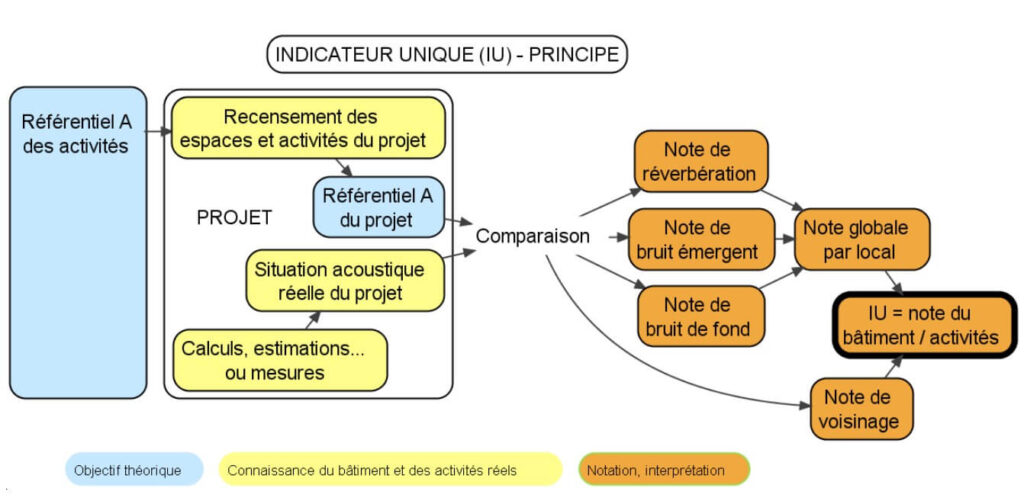Context and challenges
As a factor of comfort inside buildings, acoustic insulation protects against noise pollution, whether it comes from outside or inside.
Successive acoustic regulations have contributed to the significant improvement of the acoustic quality of the building. Depending on the type of building (residential or tertiary), they lay down requirements relating to acoustic insulation between premises, vis-à-vis the outside and common areas for impact noise and building noise, equipment, whether individual or collective.
However, dealing exclusively with the acoustic performance specific to buildings, these regulations do not make it possible to understand the acoustic performance of the building as a whole, taking into account the activities that are practiced in each room.
Definition
In buildings, there are two types of noise:
- structure-borne noise, or impact noise, which originates from a shock or vibration, transmitted by vibrating the structure and walls of the building. These noises are particularly associated with walls and floors (footsteps, impact against the wall, moving furniture, slamming doors, etc.). They also include noise from equipment, collective (elevators, boiler room, etc.) or individual (toilet flushing, taps, etc.);
- Airborne noise, i.e. noise that propagates directly in the air, emitted by a source that has no contact with the built structure (noise from outside traffic, human voices, radio or TV, etc.).
For better acoustic comfort in a room (bedroom, bathroom, living room, etc.), there are two essential concepts to take into account. On the one hand, acoustic or phonic insulation which protects against noise from outside the room; on the other hand, the acoustic correction which makes it possible to reduce the sound reverberation in this room via the walls, the ceiling or the floor.
The work carried out by the Alliance HQE-GBC
To express the quality of a building’s soundscapes according to a single indicator that is easy to read and understand, the Alliance HQE-GBC, in partnership with various scientific and technical organisations*, conducted a campaign to develop methods of evaluation and acoustic display, reflections of the real performance perceived by the user whatever the place and for any activity.
The main innovation of the approach lies in the quantification of the main acoustic characteristics of an activity both in its potentially aggressive component towards the neighborhood and in its noise-sensitive component.
While the study showed that it was not possible to assign a single sound environment indicator to a building as such, it demonstrates that it is indeed possible to assign a single and relevant rating of the acoustic quality of a building in relation to the activities carried out there.
The method and its reference
The working group led by CINOV-GIAC has retained the qualitative definitions of the following five classes:
| A | A Very comfortable place, without restriction within the framework of the "intended" use |
| B | Ditto? A but with occasional inconveniences in time and/or space |
| C | Normal use / regulatory compliance, assumes some usage restrictions |
| D | Involves strong usage restrictions / regulatory non-compliance |
| E | Unsanitary / unsuitable for use |
| Strict compliance with regulatory requirements, when they exist, should generally correspond to class C | |
The method proposes to establish an acoustic performance benchmark corresponding to class A and a method to situate the project to be rated in relation to this benchmark and thus to assign it a classification ranging from A to E.
Initially, the noise aggression, the acoustic acceptance and the desired reverberation were defined and quantified, three data which make it possible to characterize, from an acoustic point of view, any room and the human activity which takes place there. The “unrestricted” characteristics of the activities therefore corresponding to class A have been retained for this set of reference data. For this reason, it has been called the A reference frame of activities.
This reference A of the activities is then applied to the building and adjusted in order to define a reference A specific to the project.
By comparison with this reference A of the project, it is possible to note the real acoustic situation of each pair activity/space of the project (known by the calculation or by the measurements) according to three fundamental criteria: the background noise, the emerging noises and reverberation. The single indicator for the building is then the summary of the overall scores for each activity/space pair.
This approach has many advantages because it is a general approach that can be very precise and complete depending on the use made of it. Once digitized, it is very easy to use and the building owner’s only mission is to clearly identify the activities associated with the building.

*GIAC (Groupement de l’Ingénierie Acoustique), CICF (Chambre de l’Ingénierie et du Conseil de France)